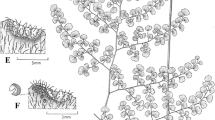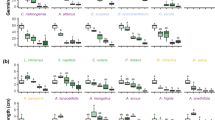Abstract
The life cycle and autoecology of three Mediterranean thorny species,Onopordum nervosum (Iberian endemic),Cirsium scabrum (Western Mediterranean) andCarthamus arborescens (Iberian-North African), of potential use in agriculture as bioenergetic, forage or oil producing plants were studied. These threeCardueae spp. are good examples of ways in which Mediterranean plants adapt their typical annual cycle to avoid summer droughts.O. nervosum is a perennial, monocarpic, heliophilous species which flowers in early summer and grows even under the extreme xeric conditions of the Mediterranean summers. It is a basiphilous plant usually found in sandy-loamy and sandy-clayey-loamy soils with a marked geographical variability in its seed germination.C. scabrum is a perennial, monocarpic species which has a long life cycle, flowering in summer and growing only during the wet months. It is not well-adapted to droughts and is usually restricted to acid soils.C. arborescens is a perennial, polycarpic species which flowers in spring and dries up in summer. It is usually found in basic loamy-sandy or sandy-loamy soils poor in organic matter.
Similar content being viewed by others
References
Alcaraz-Ariza, F. J., 1984: Flora y vegetación del N.E. de Murcia. — Murcia: Universidad de Murcia.
Bawer, G. A., Rundel, P. W., Parsons, D. J., 1982: Comparative phenology and growth in three chaparral shrubs. — Bot. Gaz.143: 94–100.
Galvez, C., Clemente-Muñoz, M., Parra-Rincon, M. A., Torrent-Castellet, J., Hernandez Bermejo, J. E., 1986: Biological cycle and adaptive strategies of three nonannual nitrophilous IberianCardueae (Onopordum nervosum, Carthamus arborescens andCirsium scabrum). — 5 Cong. Optima, Istanbul (Turkey). Abstract.
Mooney, H. A., Dunn, E. L., 1970: Convergent evolution of Mediterranean climate evergreen sclerophyll shrubs. — Evolution24: 293–303.
Olsen, S. R., Cole, C. V., Watanabe, F. S., Dean, L. A., 1954: Estimation of available phosphorous in soils by extraction with sodium bicarbonate. Circular no. 939, U.S.D.A. — Washington, D.C.: U.S. Government Printing Office.
Perez Garcia, F., Duran, J. M., 1983: Presencia de inhibidores ácidos en las semillas deOnopordum nervosum Boiss. (Compositae). — 5 Reunión Soc. Esp. Fis. Veg. (Murcia), 153.
Rigual Magallon, A., 1972: Flora y vegetación de la provincia de Alicante. — Alicante: Instituto de Estudios Alicantinos, 359.
Talavera, S., Valdes, B., 1976: Revisión del géneroCirsium (Compositae) en la Península Ibérica. — Lagascalia5: 5127–5223.
Walkley, A., Black, I. A., 1934: An examination of the Degtjareff method for determining soil organic matter and a proposed modification of the chromic acid titration method. — Soil Aci.37: 29–38.
Willkomm, H. M., Lange, J., 1870: Prodomus Florae Hispanicae. 2. — Stuttgart.
Author information
Authors and Affiliations
Rights and permissions
About this article
Cite this article
Gálvez, C., Bermejo, J.E.H. Life cycle and adaptive strategies of three non-annual, ruderalCardueae: Onopordum nervosum, Carthamus arborescens, andCirsium scabrum . Pl Syst Evol 171, 117–128 (1990). https://doi.org/10.1007/BF00940599
Received:
Issue Date:
DOI: https://doi.org/10.1007/BF00940599




